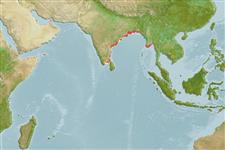Environment: milieu / climate zone / depth range / distribution range
Écologie
marin; eau douce; saumâtre; amphidrome (Ref. 51243); profondeur 0 - 50 m (Ref. 189). Tropical; 26°N - 7°N, 76°E - 99°E (Ref. 189)
Indian Ocean: eastern coasts and estuaries of India, and also Irrawaddy River at Rangoon, Myanmar. All Indian references to a species with over 7 pectoral filaments must apply to Coilia reynaldi.
Taille / Poids / Âge
Maturity: Lm ? range ? - ? cm
Max length : 15.0 cm TL mâle / non sexé; (Ref. 189)
Description synthétique
Morphologie | Morphométrie
Épines dorsales (Total): 0; Épines anales 0; Rayons mous anaux: 80. Body tapering, belly rounded before pelvic fins, with 6 to 9 + 7 to 11 = 13 to 19 keeled scutes from just behind pectoral fin base to anus. Maxilla short, not reaching to edge of gill cover. Pectoral fin with 10 to 13 long filaments; the branched fin rays much shorter those of pelvic fin.
Occurs in coastal and tidal stretches of rivers, but apparently no data on salinity tolerances. Its presence above Barrackpore on the Hooghly in India suggests that it can live in freshwater. Larvae feed on copepods; thereafter mainly on copepods, but also on prawns, larval decapods and other crustaceans. Breeds in the lower parts of estuaries. The time and duration of the breeding season reported vary for different estuaries in India.
Life cycle and mating behavior
Maturité | Reproduction | Frai | Œufs | Fécondité | Larves
Breeds in lower parts of estuaries (Ref. 189). Spawn in school (Ref. 205).
Whitehead, P.J.P., G.J. Nelson and T. Wongratana, 1988. FAO Species Catalogue. Vol. 7. Clupeoid fishes of the world (Suborder Clupeoidei). An annotated and illustrated catalogue of the herrings, sardines, pilchards, sprats, shads, anchovies and wolf-herrings. FAO Fish. Synop. 125(7/2):305-579. Rome: FAO. (Ref. 189)
Statut dans la liste rouge de l'IUCN (Ref. 130435)
Menace pour l'homme
Harmless
Utilisations par l'homme
Pêcheries: intérêt commercial mineur
Plus d'informations
Taille/ÂgeCroissanceLongueur-poidsLongueur-longueurFréquences de longueursMorphométrieMorphologieLarvesDynamique des populations larvairesRecrutementAbondanceBRUVS
RéférencesAquacultureProfil d'aquacultureSouchesGénétiqueElectrophoresesHéritabilitéPathologiesTraitementNutrientsMass conversion
CollaborateursImagesStamps, Coins Misc.SonsCiguateraVitesseType de nageSurface branchialeOtolithesCerveauxVision
Outils
Articles particuliers
Télécharger en XML
Sources Internet
Estimates based on models
Preferred temperature (Ref.
123201): 27.9 - 28.9, mean 28.4 °C (based on 48 cells).
Phylogenetic diversity index (Ref.
82804): PD
50 = 0.5001 [Uniqueness, from 0.5 = low to 2.0 = high].
Bayesian length-weight: a=0.00282 (0.00124 - 0.00641), b=3.10 (2.92 - 3.28), in cm total length, based on LWR estimates for this Genus-body shape (Ref.
93245).
Niveau trophique (Ref.
69278): 3.3 ±0.46 se; based on food items.
Generation time: 1.6 ( na - na) years. Estimated as median ln(3)/K based on 1
growth studies.
Résilience (Ref.
120179): Haut, temps minimum de doublement de population inférieur à 15 mois (K=0.7).
Fishing Vulnerability (Ref.
59153): Low vulnerability (20 of 100).
